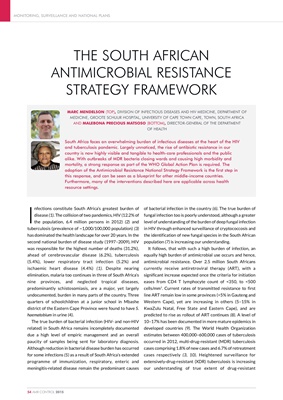
MONITORING, SURVEILLANCE AND NATIONAL PLANS
54 AMR CONTROL 2015
I
nfections constitute South Africa's greatest burden of
disease (1). The collision of two pandemics, HIV (12.2% of
the population, 6.4 million persons in 2012) (2) and
tuberculosis (prevalence of ~1,000/100,000 population) (3)
has dominated the health landscape for over 20 years. In the
second national burden of disease study (1997-2009), HIV
was responsible for the highest number of deaths (31.2%),
ahead of cerebrovascular disease (6.2%), tuberculosis
(5.4%), lower respiratory tract infection (5.2%) and
ischaemic heart disease (4.4%) (1). Despite nearing
elimination, malaria too continues in three of South Africa's
nine provinces, and neglected tropical diseases,
predominantly schistosomiasis, are a major, yet largely
undocumented, burden in many parts of the country. Three
quarters of schoolchildren at a junior school in Mbashe
district of the Eastern Cape Province were found to have S.
haematobium in urine (4).
The true burden of bacterial infection (HIV- and non-HIV
related) in South Africa remains incompletely documented
due a high level of empiric management and an overall
paucity of samples being sent for laboratory diagnosis.
Although reduction in bacterial disease burden has occurred
for some infections (5) as a result of South Africa's extended
programme of immunization, respiratory, enteric and
meningitis-related disease remain the predominant causes
of bacterial infection in the country (6). The true burden of
fungal infection too is poorly understood, although a greater
level of understanding of the burden of deep fungal infection
in HIV through enhanced surveillance of cryptococcosis and
the identification of new fungal species in the South African
population (7) is increasing our understanding.
It follows, that with such a high burden of infection, an
equally high burden of antimicrobial use occurs and hence,
antimicrobial resistance. Over 2.5 million South Africans
currently receive antiretroviral therapy (ART), with a
significant increase expected once the criteria for initiation
eases from CD4 T lymphocyte count of <350, to <500
cells/mm
3
. Current rates of transmitted resistance to first
line ART remain low in some provinces (<5% in Gauteng and
Western Cape), yet are increasing in others (5-15% in
KwaZulu Natal, Free State and Eastern Cape), and are
predicted to rise as rollout of ART continues (8). A level of
10-17% has been documented in more mature epidemics in
developed countries (9). The World Health Organization
estimates between 400,000-600,000 cases of tuberculosis
occurred in 2012, multi-drug-resistant (MDR) tuberculosis
cases comprising 1.8% of new cases and 6.7% of retreatment
cases respectively (3, 10). Heightened surveillance for
extensively-drug-resistant (XDR) tuberculosis is increasing
our understanding of true extent of drug-resistant
THE SOUTH AFRICAN
ANTIMICROBIAL RESISTANCE
STRATEGY FRAMEWORK
MARC MENDELSON (TOP), DIVISION OF INFECTIOUS DISEASES AND HIV MEDICINE, DEPARTMENT OF
MEDICINE, GROOTE SCHUUR HOSPITAL, UNIVERSITY OF CAPE TOWN CAPE, TOWN, SOUTH AFRICA
AND MALEBONA PRECIOUS MATSOTSO (BOTTOM), NATIONAL DEPARTMENT OF HEALTH, PRETORIA,
SOUTH AFRICA
South Africa faces an overwhelming burden of infectious diseases at the heart of the HIV
and tuberculosis pandemic. Largely unnoticed, the rise of antibiotic resistance in our
country is now highly visible and tangible to health-care professionals and the public
alike. With outbreaks of MDR bacteria closing wards and causing high morbidity and
mortality, a strong response as part of the WHO Global Action Plan is required. The
adoption of the Antimicrobial Resistance National Strategy Framework is the first step in
this response, and can be seen as a blueprint for other middle-income countries.
Furthermore, many of the interventions described here are applicable across health
resource settings.